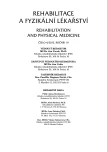Hypermobility in Sport
Authors:
L. Satrapová; T. Nováková
Authors‘ workplace:
Katedra fyzioterapie UK FTVS Praha
vedoucí katedry doc. PaedDr. D. Pavlů, CSc.
Published in:
Rehabil. fyz. Lék., 19, 2012, No. 4, pp. 199-202.
Category:
Case Report
Overview
Hypermobility of children and adults causes not only in sport a lot of various problems of locomotor apparatus. Some of sport branches encourage the development of hypermobility either local or constitutional. In the examples of several case studies we will try to show the causes of hypermobility and subsequent difficulties in various sports, medical and physiotherapeutic possibilities of intervention and whether it is real long-term compensation.
Key words:
hypermobility, sport, locomotor apparatus
Sources
1. HAKIM, A., GRAHAME, R.: Joint hypermobility. Best Practice & Research Clinical Rheumatology, 17, 2003, 6, s. 989-1004.
2. JANDA, V.: Hypermobilita. Doporučené postupy pro praktické lékaře, ČLS JEP, 2001.
3. RUSSEK, L.: Hypermobility syndrome. Physical Therapy, 79, 1999, s. 591-599.
4. RUSSEK, L.: Examination and treatment of a patient with hypermobility syndrome. Physical Therapy, 80, 2000, s. 386-398.
5. SIMMONDS, J., KEER, R.: Hypermobility and the hypermobility syndrome. Manual Therapy, 12, 2007, s. 298-309.
6. SIMPSON, M.: Benign joint hypermobility syndrome: Evaluation, Diagnosis and management. Journal of American Ostheopath, 106, 2006, 9, s. 531-536.
7. TOFTS, L., ELLIOT, E., MUNNS, C., PACEY, V., SILLENCE, D.: The differential diagnosis of children with joint hypermobility: a review of the literature. Pediatric Rheumatology, 7, 2009.
8. VÉLE, F.: Kineziologie pro klinickou praxi. Praha, Grada Publishing, 1997.
Labels
Physiotherapist, university degree Rehabilitation Sports medicineArticle was published in
Rehabilitation & Physical Medicine

2012 Issue 4
Most read in this issue
- Possibilities of Spa Therapy in Patients with Idiopathic Scoliosis
- Diagnostics of the Foot Function in Daily Practice
- Hypermobility in Sport
- Functional Diagnostics – Precondition for the Physiotherapist’s Success
